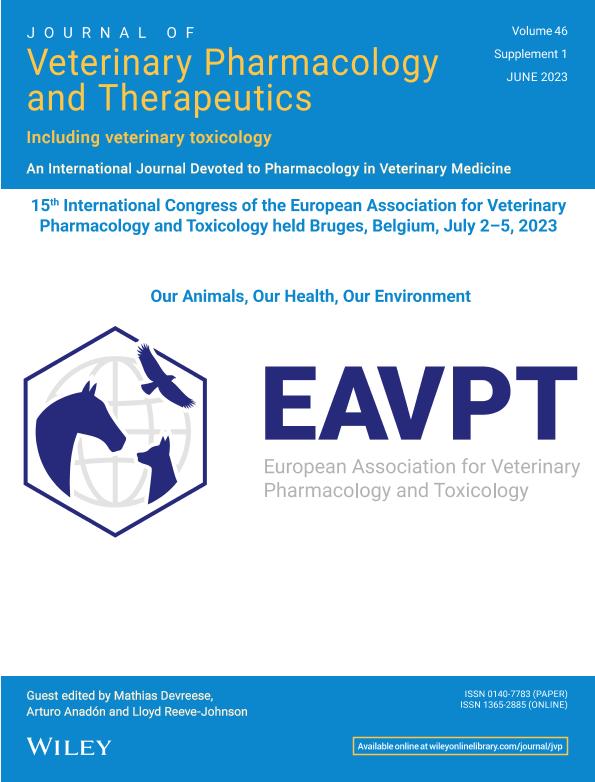Evento
Antibacterial drug residues in animal tissues for human consumption: monitoring and exposure assessment
Cantón, Lucila ; Cantón, Candela
; Cantón, Candela ; Dominguez, Maria Paula
; Dominguez, Maria Paula ; Farias, Cristina Elena
; Farias, Cristina Elena ; Valente, Marcela
; Valente, Marcela ; Alvarez, Luis Ignacio
; Alvarez, Luis Ignacio ; Lanusse, Carlos Edmundo
; Lanusse, Carlos Edmundo ; Signorini, Marcelo; Moreno Torrejon, Laura
; Signorini, Marcelo; Moreno Torrejon, Laura
 ; Cantón, Candela
; Cantón, Candela ; Dominguez, Maria Paula
; Dominguez, Maria Paula ; Farias, Cristina Elena
; Farias, Cristina Elena ; Valente, Marcela
; Valente, Marcela ; Alvarez, Luis Ignacio
; Alvarez, Luis Ignacio ; Lanusse, Carlos Edmundo
; Lanusse, Carlos Edmundo ; Signorini, Marcelo; Moreno Torrejon, Laura
; Signorini, Marcelo; Moreno Torrejon, Laura
Tipo del evento:
Congreso
Nombre del evento:
15th International Congress of The European Association for Veterinary Pharmacology & Toxicology
Fecha del evento:
02/07/2023
Institución Organizadora:
European Association for Veterinary Pharmacology & Toxicology;
Título de la revista:
Journal of Veterinary Pharmacology and Therapeutics
Editorial:
Wiley
ISSN:
0140-7783
e-ISSN:
1365-2885
Idioma:
Inglés
Clasificación temática:
Resumen
Introduction: Argentina is traditionally a beef producer country. However, in recent years pork and chicken production have widely grown. These productions are closely linked to veterinary drug use for bacterial control. Accordingly, if good veterinary practices are not followed, food of animal origin could contain drug residues above the Maximum Residue Limit (MRL). Antibacterial drug residues in animal tissues may induce toxic or allergic reactions and promote antimicrobial resistance with a serious impact on human health. Residue monitoring programs consist of foodstuff sampling to determine potential drug residues. This study aimed to monitor, asses the exposure, and characterize the potential risk of antibacterial residues in animal products for local consumption in Buenos Aires province (Argentina). Materials and Methods: Antibacterial residues of enrofloxacin (EFX), amoxicillin (AMX), oxytetracycline (OTC), tilmicosin (TIL), and monensin (MON) were monitored in edible tissues from bovine, pork, and chicken species. Based on the Argentinian food culture, the following edible tissues were purchased from supermarkets, butchers, poultry shops, and retail stores in the cities involved in the trial: 360 meat (150 beef, 111 pork, and 89 chicken), 360 fat (150 beef fat, 111 pork fat, and 89 chicken fat), 91 beef liver, 78 beef kidney, and 33 sweetbreads samples. Tissue samples were analyzed by HPLC-fluorescence or UFLC-MS/MS. Considering that the tissues are not consumed raw, based on previously reported data, antibacterial residue stability during conventional cooking methods was contemplated for the analysis. Finally, factors such as antibacterial residue prevalence; residue concentrations; residue stability after different cooking methods; and bovine, pork, and chicken tissue consumption, were modeled by the @Risk software to predict the probability of consuming tissues with residues above the Admitted Daily Intake. Results and Conclusions: EFX, OTC, AMX, TIL, and MON antibacterial residues were found in bovine, pork, and chicken tissues. 9.4% of collected tissue samples had quantifiable drug residue levels and 2.7% had residue concentrations exceeding the MRL out of 922 targeted samples. Taking into account the levels of quantified antibacterial residues, the exposure to them, and the characterization of the risk by the described methodology, it was concluded that these antibacterial residues do not constitute a direct risk to consumers' health. However, the high frequency of antibacterial drug residues at detectable levels found in food should not be ignored, due to their possible contribution to the development of bacterial resistance when ingested and therefore with indirect consequences on health.
Palabras clave:
ANTIBACTERIALS
,
DRUG RESIDUES
,
EXPOSURE ASSESSMENT
Archivos asociados
Licencia
Identificadores
URL:
https://eavpt23.org
Colecciones
Eventos(CIVETAN)
Eventos de CENTRO DE INVESTIGACION VETERINARIA DE TANDIL
Eventos de CENTRO DE INVESTIGACION VETERINARIA DE TANDIL
Citación
Antibacterial drug residues in animal tissues for human consumption: monitoring and exposure assessment; 15th International Congress of The European Association for Veterinary Pharmacology & Toxicology; Brujas; Bélgica; 2023; 127-127
Compartir
Altmétricas



